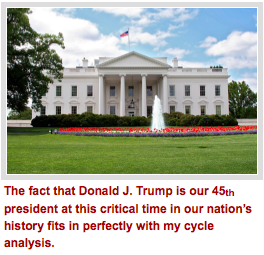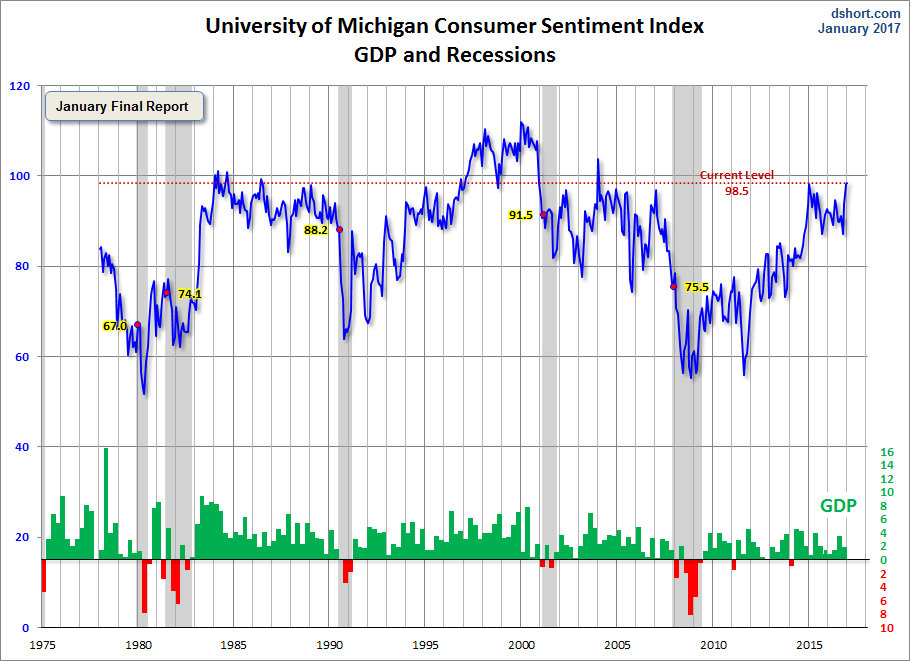Economic Outlook
The University of Michigan Final Consumer Sentiment for January came in at 98.5, up from the December Final reading. Investing.com had forecast 98.1.
Surveys of Consumers chief economist, Richard Curtin, makes the following comments:
Consumers expressed a higher level of confidence January than any other time in the last dozen years. The post-election surge in confidence was driven by a more optimistic outlook for the economy and job growth during the year ahead as well as more favorable economic prospects over the next five years. Consumers also reported much more positive assessments of their current financial situation due to gains in both incomes and household wealth, and anticipated the most positive outlook for their personal finances in more than a decade. Consumers have become more convinced that the stronger economy would finally prompt the Fed to increase interest rates at a quicker pace, which caused one-in-five consumers to favor borrowing-in-advance of anticipated increases in mortgage rates, the highest level in more than twenty years. Overall, the post-election surge in consumer confidence was based on political promises, and not, as yet, on economic outcomes. Moreover, over the past half century the surveys have never recorded as dominant an impact of partisanship on economic expectations. When the same consumers were re-interviewed from six months ago, the survey recorded extreme swings based on political party affiliation, with Democrats becoming much more pessimistic and Republicans much more optimistic. Such divergences will ultimately converge since consumers hold economic expectations to be useful decision guides, which will require both sides to temper their extreme views. [More…]
See the chart below for a long-term perspective on this widely watched indicator. Recessions and real GDP are included to help us evaluate the correlation between the Michigan Consumer Sentiment Index and the broader economy.
…read more from FinancialSense.com HERE
…also:

On President Trump’s first day in the Oval Office, he made good on his campaign promise to “rip up” trade deals he thinks are unfavorable to the U.S. economy by withdrawing from the Trans-Pacific Partnership trade negotiations.
And mark my words, this is only the beginning.
Not long after Trump’s election win – a surprise to most investors, but an outcome I predicted in advance thanks to my cycle analysis – I’m on record saying: “I have no doubt that he will follow through on this promise. He was clear about one goal throughout his campaign: Getting much tougher on trade relations.”
My cycles and AI models warned you to expect chaos in the global economy and financial markets, including a worldwide sovereign bond crisis. This was long before Mr. Trump even decided to run for president.
 The truth is, we were heading down this path no matter who became our next Commander in Chief. But the fact that Donald J. Trump is our 45thpresident at this critical time in our nation’s history, indeed in the annals of world history, fits in perfectly with my cycle analysis.
The truth is, we were heading down this path no matter who became our next Commander in Chief. But the fact that Donald J. Trump is our 45thpresident at this critical time in our nation’s history, indeed in the annals of world history, fits in perfectly with my cycle analysis.
Look, this is the guy who authored “The Art of the Deal” and “The Art of the Comeback.” So make no mistake, he fully intends to use the same hard-ball negotiating tactics when it comes to a broad range of issues including:
- Foreign trade talks…
- Confronting China …
- Levying tariffs and taxes on imports …
- Even combating Isis and terrorism in general
As I said, this is just the beginning. Going forward, expect more divisive politics and social unrest that will make the million-women march look like a tea party. Ultimately, you can expect an end to the era of big government, not just in the U.S., but worldwide.
The old order that has been in place since WWII is about to come crashing down. The era in which governments amassed an unsustainable $275 trillion in total debts and obligations is quickly coming to a painful end.
Best wishes,
Larry
P.S. We are in for five years of chaos in the economy, the markets and in our business and personal lives. As this supercycle courses through the world economy in the months ahead, the investors our governments count on for loans will snap their wallets shut. Even now, investors are reading the handwriting on the wall: Government debt is simply too massive. It can never be repaid. It would be financial suicide for them to continue loaning their money to Brussels, Tokyo or Washington; insane to throw good money after bad. And so, governments — including our own — will simply run out of money. Read more here …
Financial markets, global currencies, even our societies have been built on this shaky foundation of debt, and it’s about to topple. Over the next four years, President Trump and his policies will play a key role in these events, just as my cycles forecast.

 To broaden the debate given the number of disagreements posted on Facebook since the article posted on this site January 4th titled “Peer-Reviewed Survey Finds Majority Of Scientists Skeptical Of Global Warming Crisis”, I am sending links to three articles below, 1 for, one against, and one fascinating youtube by a scientist that illustrates the amount of Carbon Dioxide in the atmosphere (.038%):
To broaden the debate given the number of disagreements posted on Facebook since the article posted on this site January 4th titled “Peer-Reviewed Survey Finds Majority Of Scientists Skeptical Of Global Warming Crisis”, I am sending links to three articles below, 1 for, one against, and one fascinating youtube by a scientist that illustrates the amount of Carbon Dioxide in the atmosphere (.038%):
For: From NASA – Study sheds new insights into global warming trends (2016)
Factual information on Carbon Dioxide in the Atmosphere: Carbon Dioxide in perspective by The Galileo Movement
Robert Zurrer
Editor
Moneytalks.net
Late addition: As Donald Trump Denies Climate Change, These Kids Die of It

 It is becoming clear that not only do many scientists dispute the asserted global warming crisis, but these skeptical scientists may indeed form a scientific consensus.
It is becoming clear that not only do many scientists dispute the asserted global warming crisis, but these skeptical scientists may indeed form a scientific consensus.
Don’t look now, but maybe a scientific consensus exists concerning global warming after all. Only 36 percent of geoscientists and engineers believe that humans are creating a global warming crisis, according to a survey reported in the peer-reviewed Organization Studies. By contrast, a strong majority of the 1,077 respondents believe that nature is the primary cause of recent global warming and/or that future global warming will not be a very serious problem.

 The optimism that has followed the election of Donald Trump has pushed the Dow Jones Industrial Average to the threshold of 20,000, a level that will be both a nominal record and a symbolic milestone. Although this is not the way most observers had predicted that 2016 would play out, most on Wall Street have become extremely reluctant to look a gift horse in the mouth…or to even look at him at all. The impulse is to jump on and ride, and only ask questions if it pulls up lame. But if this year has proven one thing, it is that predictions made by the consensus should not be trusted.
The optimism that has followed the election of Donald Trump has pushed the Dow Jones Industrial Average to the threshold of 20,000, a level that will be both a nominal record and a symbolic milestone. Although this is not the way most observers had predicted that 2016 would play out, most on Wall Street have become extremely reluctant to look a gift horse in the mouth…or to even look at him at all. The impulse is to jump on and ride, and only ask questions if it pulls up lame. But if this year has proven one thing, it is that predictions made by the consensus should not be trusted.
Back in the earlier part of 2016 the mood was decidedly darker. At that point most people believed that the Federal Reserve would be raising rates throughout the course of the year. While such hikes had been anticipated (and delayed) for years, most took comfort in the belief that the economy would be expanding nicely by the time the Fed actually pulled the trigger. But in late 2015, the already tepid GDP growth seen in the prior two years seemed to be decelerating. Investors also concluded that Hilary Clinton was a lock to win the election, thereby assuring that the anti-growth policies of the Obama years would continue. Many looked at these developments and concluded that the sins of the past decade, in which the Government and the Federal Reserve had used unprecedented levels of fiscal and monetary stimulus to prop up the economy and the stock market, had finally caught up with us. As a result, the Dow Jones shed more than seven per cent in the first two weeks of the year, its worst start on record.
But the year comes to an end amid a cloud of Trump-fueled bullishness. The markets fully embrace an unapologetic capitalist, and his team of billionaires, who promises to cut taxes, rewrite trade deals in America’s favor, take a machete to anti-growth regulations, repeal Obamacare, and return America to its former industrial might. Many are making parallels to the Reagan Revolution in which a maverick anti-establishment Republican took charge in Washington and ignited an economic boom, a stock market rally and a surge in the dollar. But to make this comparison, boosters must jump over a more telling comparison to the last Republican president elected, George W. Bush.
The parallels to W. are striking. Both lost the popular vote, and will have taken office following the tenure of a two-term Democrat who had presided over a furious stock market bubble and a surging dollar. In the 4 years prior to Bush’s election, the Dow Jones had surged approximately 60% and the dollar index had risen approximately 19% (1/2/97 to 12/29/2000). For Trump, the numbers are 48% and 24% (1/2/13 to 12/21/16). Then, as now, the U.S. was seen by investors as the only game in town. Clinton’s second term was rife with global crises that both created safe-haven flows into the dollar and caused the Fed to backstop U.S. financial markets with cheap money (at least cheap by the standard that existed at the time). Both will have come into office promising tax cuts and regulatory relief following eight years of Democratic reign. As a result, the market gains of the Clinton and Obama years were expected to continue under their Republican successors.
But the optimists did not anticipate that the big, fat, ugly bubble that inflated during Clinton’s second term, would burst early in Bush’s first term (although the air started coming out of that bubble while Clinton was still in office). Given the ensuing recession of 2001, it can be argued that the only reason Bush was reelected in 2004 was that the Fed was able to inflate an even bigger, fatter, and uglier bubble in housing that postponed the pain until the financial crisis of 2008. That is where the similarities will likely end, as Trump will likely not be that lucky.
One of the pillars of dollar strength under Clinton was eight straight years of deficit reductions, culminating with a massive $236 billion budget surplus in 2000 (Congressional Budget Office). While the surplus did require some accounting smoke and mirrors and a stock market bubble to create, it nonetheless marked a significant achievement. At that point, many economists had assumed that the U.S. debt problem had largely been solved and that the country would ride a wave of permanent surplus. The only problem most could envision was a shortage of Treasury bonds once the national debt was fully repaid. No one is to worried about that “problem” now.
Similarly, Trump is taking charge at a time when official budget deficits have fallen consistently since 2009 (albeit from astronomically high levels). But 2016 is projected to be the first year since 2009 in which the deficit will have risen, significantly, from the prior year. The Congressional Budget Office sees a return to perpetual $1 trillion plus annual deficits in the early part of the next decade (The Budget and Economic Outlook: 2016 to 2026 report, January 2016), even if we have no tax cuts, spending increases or recessions over that entire time. Under the Trump presidency, we are likely to get all three.
If a recession comes early in Trump’s presidency, it will be no more his fault than the 2001 recession can be blamed on Bush. A sharp pullback has been years in the making. Firstly, there is simply the issue of timing. On average, the U.S. has experienced a recession every 60 months or so since WW II (based on data from National Bureau of Economic Research and Bureau of Labor Statistics).The current expansion is already 90 months old, or 50% longer than average. Sooner, rather than later, it will have an end date. Recessions completely reshuffle the budgetary deck, causing government outlays to rise and revenues to fall simultaneously. The swings can be dramatic. The 1981-1982 recession resulted in a 61% increase in Federal red ink. The recession of 2001 turned a $236 billion surplus in 2000 into a $377 billion deficit in 2003 (then a record). The Great Recession of 2008-2009 caused the $458 billion deficit in 2008 to more than triple to $1.4 trillion in 2009. Rest assured, the next recession can cause a similar catastrophe to the government’s finances.
Trump’s election was predicated on his intention to buck traditional Republican policy of fiscal restraint. He has promised tax cuts for people and corporations and massive $1 trillion plus spending binges on infrastructure and the military. Of course the argument goes that these moves will stimulate growth thereby raising tax revenue to pay for both the cuts and the spending. The same arguments were made by George W. Bush in 2001 when he cut taxes, increased spending, and pushed through a temporary tax holiday to encourage corporations to repatriate money held overseas. Deficits soared anyway. The only real question is will the recession arrive before or after Trump’s fiscal policies kick in. If the events happen simultaneously, the budgetary implications will be hard to fathom.
Investors who are basking in the Trump victory should take a hard look at what happened to the markets during the Bush presidency. In mid-2008 (just a few months before the financial crisis sent stocks plummeting), the S&P 500 was just 17% above the level when Bush was elected nearly eight years earlier. The dollar, in particular, took a beating under Bush. In August 2008 (right before the dollar rallied temporarily as a result of the panic), the dollar index had fallen by 19% since his election. The opposite occurred in gold. In November of 2000, gold was at about $370 per ounce, close to a 20 plus year low. In August 2008, it was more than $920, down significantly from it’s high of almost $1,100 hit earlier that year.
Also, for all the optimism about the U.S. stock market and pessimism abroad, it was foreign markets that delivered for investors. From Bush’s election to mid-2008, just before the global financial crisis sent stocks reeling around the globe, developed foreign markets were up 80% (priced in U.S. dollars) while emerging markets were up a staggering 300% (priced in U.S. dollars). Even if you include the huge losses in the back half of 2008, by the time Obama was sworn in, developed markets were down less than 3% from the time of Bush’s election, and emerging markets were still up about 80%. (In contrast, the S&P 500 was down almost 27%).
The 2001 Recession, which was triggered by the bursting of the dotcom bubble and the September 11 attacks, came very early in Bush’s first term. Fortunately for W., the Federal Reserve was able to support the economy by bringing rates down from more than 6% to just 1% (Federal Reserve Bank of St. Louis) (which helps explain the swift collapse of the dollar). As a result, the 2001 recession was the shortest and mildest on record. In doing so, however, the Fed blew up an even bigger bubble in real estate, the bursting of which created a far bigger recession in 2008, propelling Obama into the White House.
But can the Fed ride to the rescue this time around? Given that rates are practically zero and the Fed is choking on trillions of dollars of assets that are permanently held on its balance sheet, the answer is clearly no. All the Fed will be able to do is launch the mother of all QE programs, perhaps in the form of a massive helicopter drop. But the bad news for Trump fans is that the result will not be a housing bubble like the one that bailed out Bush, but a wave of stagflation that will make Trump a one-termer. The nightmare scenario is that once again tax cuts and deregulation take the blame, allowing Bernie Sanders or a socialist candidate to ride another populist wave, only this one headed far left, into the White House of 2020.
Best Selling author Peter Schiff is the CEO and Chief Global Strategist of Euro Pacific Capital. His podcasts are available on The Peter Schiff Channel on Youtube.













